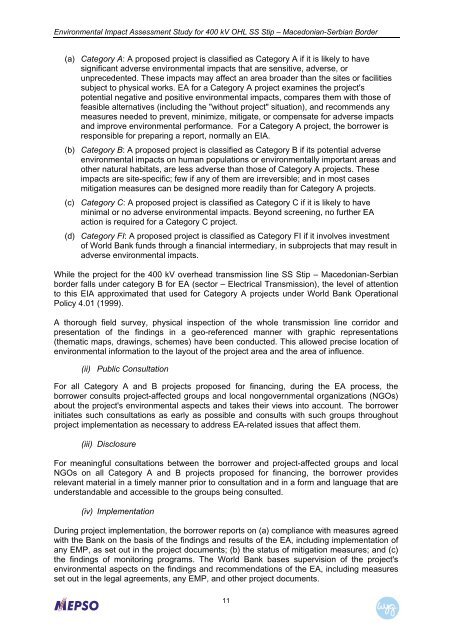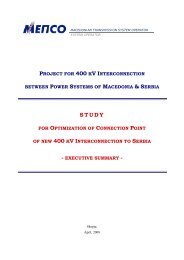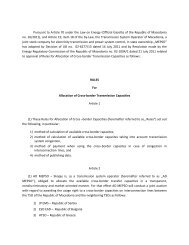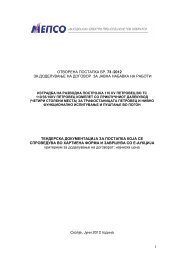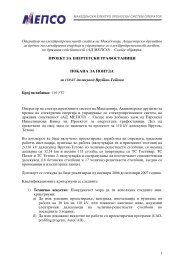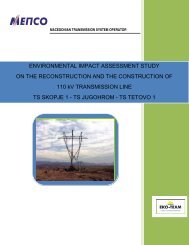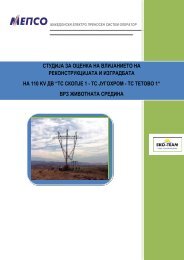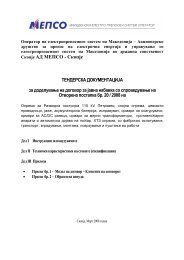Part A - EIA 400 kV OHTL Stp - мепÑо а.д.
Part A - EIA 400 kV OHTL Stp - мепÑо а.д.
Part A - EIA 400 kV OHTL Stp - мепÑо а.д.
Create successful ePaper yourself
Turn your PDF publications into a flip-book with our unique Google optimized e-Paper software.
Environmental Impact Assessment Study for <strong>400</strong> <strong>kV</strong> OHL SS Stip – Macedonian-Serbian Border(a) Category A: A proposed project is classified as Category A if it is likely to havesignificant adverse environmental impacts that are sensitive, adverse, orunprecedented. These impacts may affect an area broader than the sites or facilitiessubject to physical works. EA for a Category A project examines the project'spotential negative and positive environmental impacts, compares them with those offeasible alternatives (including the "without project" situation), and recommends anymeasures needed to prevent, minimize, mitigate, or compensate for adverse impactsand improve environmental performance. For a Category A project, the borrower isresponsible for preparing a report, normally an <strong>EIA</strong>.(b) Category B: A proposed project is classified as Category B if its potential adverseenvironmental impacts on human populations or environmentally important areas andother natural habitats, are less adverse than those of Category A projects. Theseimpacts are site-specific; few if any of them are irreversible; and in most casesmitigation measures can be designed more readily than for Category A projects.(c) Category C: A proposed project is classified as Category C if it is likely to haveminimal or no adverse environmental impacts. Beyond screening, no further EAaction is required for a Category C project.(d) Category FI: A proposed project is classified as Category FI if it involves investmentof World Bank funds through a financial intermediary, in subprojects that may result inadverse environmental impacts.While the project for the <strong>400</strong> <strong>kV</strong> overhead transmission line SS Stip – Macedonian-Serbianborder falls under category B for EA (sector – Electrical Transmission), the level of attentionto this <strong>EIA</strong> approximated that used for Category A projects under World Bank OperationalPolicy 4.01 (1999).A thorough field survey, physical inspection of the whole transmission line corridor andpresentation of the findings in a geo-referenced manner with graphic representations(thematic maps, drawings, schemes) have been conducted. This allowed precise location ofenvironmental information to the layout of the project area and the area of influence.(ii) Public ConsultationFor all Category A and B projects proposed for financing, during the EA process, theborrower consults project-affected groups and local nongovernmental organizations (NGOs)about the project's environmental aspects and takes their views into account. The borrowerinitiates such consultations as early as possible and consults with such groups throughoutproject implementation as necessary to address EA-related issues that affect them.(iii) DisclosureFor meaningful consultations between the borrower and project-affected groups and localNGOs on all Category A and B projects proposed for financing, the borrower providesrelevant material in a timely manner prior to consultation and in a form and language that areunderstandable and accessible to the groups being consulted.(iv) ImplementationDuring project implementation, the borrower reports on (a) compliance with measures agreedwith the Bank on the basis of the findings and results of the EA, including implementation ofany EMP, as set out in the project documents; (b) the status of mitigation measures; and (c)the findings of monitoring programs. The World Bank bases supervision of the project'senvironmental aspects on the findings and recommendations of the EA, including measuresset out in the legal agreements, any EMP, and other project documents.11


